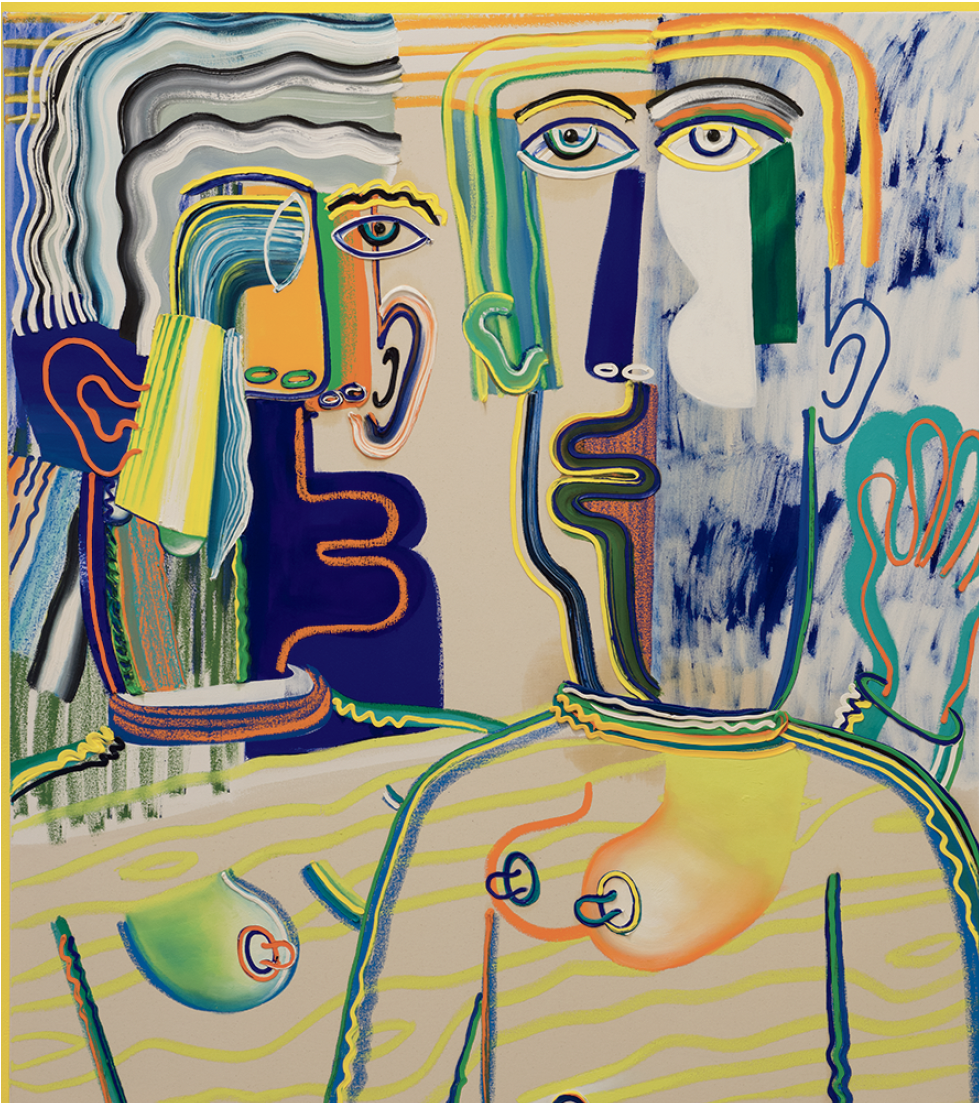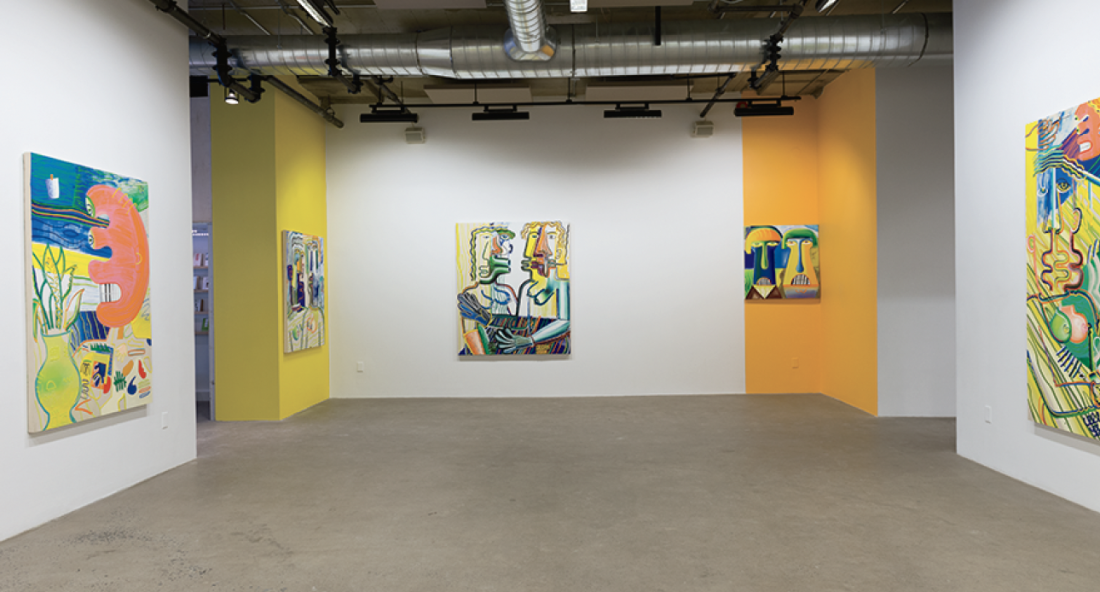Annie Hémond Hotte
If the election of Donald Trump accomplished anything, it is the return of human fallibility to the centre of political thought. Of themselves, Trumpist politics represent little that’s truly new—the true failure of America surely spans a halfcentury— yet this man’s rise has finally pulled back the curtain on a shabby public theatre: politics as slapstick, representation as swindle, leadership as farce. The house is sold out, of course.
Art lovers wondering where to turn would have enjoyed “Panic Myth,” a suite of paintings by Annie Hémond Hotte, on exhibition this past spring at Montreal’s Centre Clark. Based in New York City, Hémond Hotte confronts the failure of ideologies. Technology, the god we all worship unquestioningly, has brought us a surveillance society and global warming. Capitalism, as always, rewards the rich, but no longer promises, at least not convincingly, to “lift all boats.” Clintonism and Trumpism, meanwhile, claim to redress these deficits by force of personality alone.
Hémond Hotte’s paintings examine this linkage between failed ideology and the deformed political personality. Her characters— monstrous yet pathetic, in conflict with one another and themselves— function more as dysfunctional gods or heroes than as ordinary people. In The Monumentals, for instance, two massive figures, male and female (Trump and Clinton?), with Trump-like haircuts, occupy most of the frame in an hilarious “American gothic” scenario. In the vein of Juan Gris, the two are stuck, flattened against the landscape they occupy.

Annie Hémond Hotte, Shaman Selfie (The Constructivists), 137 x 122, oil paint and mixed media on canvas, 2016. All photos: Paul Litherland. All images courtesy of the artist and Centre Clark, Montreal.
Shaman Selfie depicts two female shamans, the arm of one around the other. One appears to have a prosthetic eye. In pathetic mimicry of traditional shamans who could disassemble and reassemble their bodies or exchange body parts with animals, these two partake in today’s most popular act of pointless self-construction.
Dominating the exhibition is a very large painting, The War of the Gods, which shows several god-characters in conflict amidst luxuriant jungle foliage. One monstrous Janus-faced god reaches for another’s conspicuous yellow breasts. Another, quite despondent, reaches down to recover his lost hot dog, but ends up contemplating his own little weenie. The characters are simultaneously naked and clothed, with a seamless transition between topless chest and sleeved arms, often with prominent sexual organs (and ubiquitous curlicue pubic hair). The floor is strewn with diverse objects: two human heads, several vases, a Hand of Fatima and paper money bills.
The Lunatic Astronaut features a spaceman figure with a pinkyorange head, bulbous, telescoping eyes and gritted teeth between protruding lips. His body is covered with symbols recalling Matisse’s cut-outs. Earth is far away, a small green sphere at top right. In the foreground sits a potted tropical plant, its vase covered in hieroglyphs from the Egyptian Book of the Dead. The astronaut seems preoccupied with his lost soft drink, which floats away in space.
The world of these characters is an encoded one, punctuated by symbolic objects: money bills, Egyptian hieroglyphs, various allusions to the history of art. Though they could scarcely be more different in terms of colour, lighting or painting style, there is something of the Dutch history painting in Hémond Hotte’s work. Though situated in time, her works do not convey movement. Time is frozen, and the eye may ramble freely across the image, assessing each character’s condition and reading the symbols positioned about it.

Annie Hémond Hotte, installation view, “Panic Myth,” 2017, Centre Clark, Montreal.
The painted god-figures possess a monstrous affect that recalls the qualities of comic-book characters. Not superheroes, whose physical forms remain always idealized, but rather “ordinary” characters—for example, Buddy Bradley in Peter Bagge’s 1990s series “Hate”—whose faces and bodies are sometimes contorted by intense emotion, if just for a moment, into twisted, grimacing monsters. Hémond Hotte’s painted characters function similarly, using the act of bestial self-deformation to fully become themselves. In a way, this really is a superpower; few real people—aside, maybe, from George Carlin when he is talking about conservatives—can achieve it!
Since Trump’s win, fear has permeated the intellectual economy, and sales of the dystopian classics (Orwell, Huxley) have spiked. So, too, presumably, has the appeal of Margaret Atwood’s The Handmaid’s Tale, or of non-fiction “cautionary literature” such as Mike Davis’s Planet of Slums or Jared Diamond’s Guns, Germs, and Steel. Yet, for all its defeated gods and failed ideologies, Hémond Hotte’s painted world is something of a different order from these dark futures.
Indeed, but for the air conditioning, passing time in this exhibition could be how meandering through a greenhouse on some peculiarly fecund, abundant, alien jungle planet might feel. A significant departure from her earlier, much darker works, the artist’s colours are so intensely saturated—yellows, greens, oranges—they are easily taken for neons. Even the gallery’s white walls quickly come alive with complementary colours.
Like our own world, this one is strange but not monstrous—even though ideologies may fail, and gods and humans lose confidence. It may remind us that if there’s anything we need to work on, it’s getting ourselves past the fact that the future is promised to no one. ❚
“Panic Myth” was exhibited at Centre Clark, Montreal, from March 9 to April 15, 2017.
Edwin Janzen is a Winnipeg-born writer, editor and artist living in Montreal.

